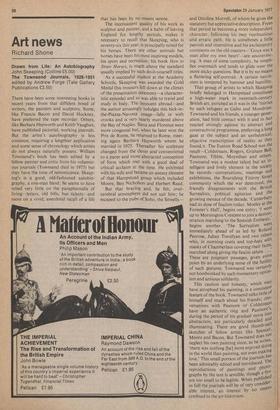Art news
Richard Shone Drawn from Life: An Autobiography John Skeaping (Collins £5.00)
The Townsend Journals, 1928-1951 edited by Andrew Forge (Tate Gallery Publications £3.50)
There have been some interesting books in recent years from that diffident breed of writers, the painters and sculptors. Some, like Francis Bacon and David Hockney, have preferred the tape recorder. Others, like Barbara Hepworth and Keith Vaughan, have published pictorial, working journals. But the artist's autobiography is less common, requiring a lengthier application and some sense of chronology which artists do not always naturally possess. William Townsend's book has been edited by a fellow painter and critic from his voluminous journals (Townsend died in 1973) but they have the tone of reminiscence. Skeaping's is a good, old-fashioned autobiography, a one-man band; fie seems to have relied very little on the -paraphernalia of living—letters, old bills, bus tickets—and more on a vivid, anecdotal recall of a life that has been by no means serene.
The inconsistent quality of his work as sculptor and painter, and a habit of leaving England for lengthy periods, makes it necessary to recall that Skeaping, who is seventy-six this year, is principally noted for his horses. Thereare other animals but horses have been his most inspiring models, his sport and recreation; his book How to Draw Horses, is much above the standard usually implied by such do-it-yourself titles.
As a successful student at the Academy Schools, Skeaping was awarded the Gold Medal (his trousers fell down at the climax of the presentation ceremony—a characteristic episode) and so was able to travel and study in Italy. The innocent abroad—and the author amusingly indulges this hick-inthe-Piazza-Navona image—falls in with crooks and is very nearly murdered above the Bay of Naples. Siena and Florence were more congenial but, when he later won the Prix de Rome, he returned to Rome, meeting again Barbara Hepworth whom he married in 1925. Thereafter his sculpture changed from the clever and conventional to a purer and more abstracted conception of form which met with a good deal of critical acclaim at the time. He exhibited with his wife and became an uneasy element of that Hampstead group which included Moore, Ben Nicholson and Herbert Read.
But that bracing and, he felt, overcerebral atmosphere did not suit him; he escaped to the pubs of Soho, the Sitwells
and Ottoline Morrell, of whom he gives the statutory but appreciative description. From that period he becomes.a more independent character, following his Own rumbustious and erratic path. He is sometimes a little peevish and insensitive and his exclamatory comments on the old masters—`Goya was a man .after my own heart'—are unconvincing. A man of some complexity, he simPlifies overmuch and tends to glide over the more sticky questions. But it is by no means a flattering self-portrait. A certain narcissism is tempered by humour and humility.
That group of artists to which Skeaping briefly belonged in Hampstead constitutes a high-water mark in twentieth-centurY British art, enriched as it was in the 'thirties by such refugees as Gabo and Mondrian. Townsend and his friends, a younger generation, had little contact with it and in fact reacted strongly against its abstract and constructivist programme, preferring a long gaze at the subject and an unrhetorical, objective transcription of reality as they found. it. The Euston Road School was the result—Coldstream, Rogers, Graham Bell; Pasmore, Tibble, Moynihan and others. Townsend was a modest talent but an intelligent and lively element in the societY he records—conversations, meetings and exhibitions, the flourishing Fitzroy Street community which the war destroyed, the friendly disagreements with the British Surrealists, political agitation and the growing menace of the decade. CanterburY had its dose of fascism today. Mosley at the Forester's Hall', begins one entry; i went up to Mornington Crescent to join a demon-, stration marching to the Spanish Embassy, begins another. The Surrealists were immediately ahead of us led by Roland Penrose, Julian Trevelyan and two others who, in morning coats and top-hats with masks of Chamberlain covering their faces: marched along giving the fascist salute.. • These are poignant passages, given extra point by an underlying sense of the futilitY of such gestures. Townsend was certainlY not hoodwinked by such momentary optimism and anxious solidarity. This caution and honesty, which rnaY have atrophied his painting, is a consistent_ feature of the book. Townsend talks little of himself and much about his friends; conversations with Pasmore or' Coldstream have an authentic ring and PasMore during the period of his gradual move in t°. abstraction, are particularly detailed and. illuminating. There are good thumb-nail sketches of fellow artists like Spencer, Moore and Bacon. But Townsend does.not neglect his own painting since, as he writes. 'there was nothing [he] more enjoyed dol.ng
in the world than painting, not even making has has love.' This small portion of the journals
been admirably edited and introduced. The reproductions of paintings and Pilot° graphs by the text is sensible, though few, are too small to be legible. When publi.shea_ in full the journals will be or very consiedaenrs able interest, an interest by no rn confined to the art historians.










































 Previous page
Previous page